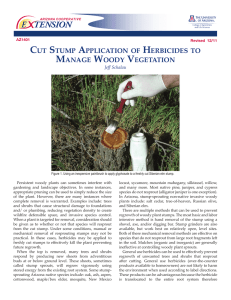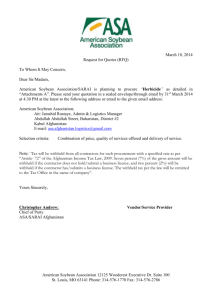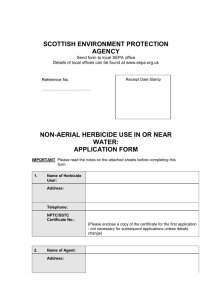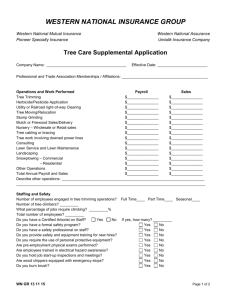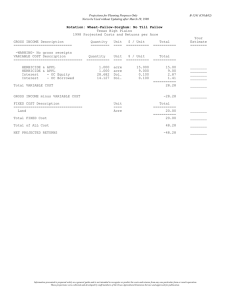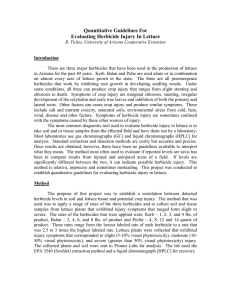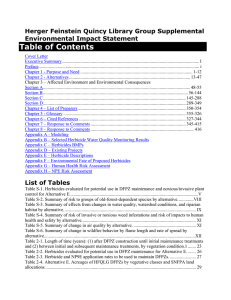Using Cut Stump Application of Herbicides to
advertisement
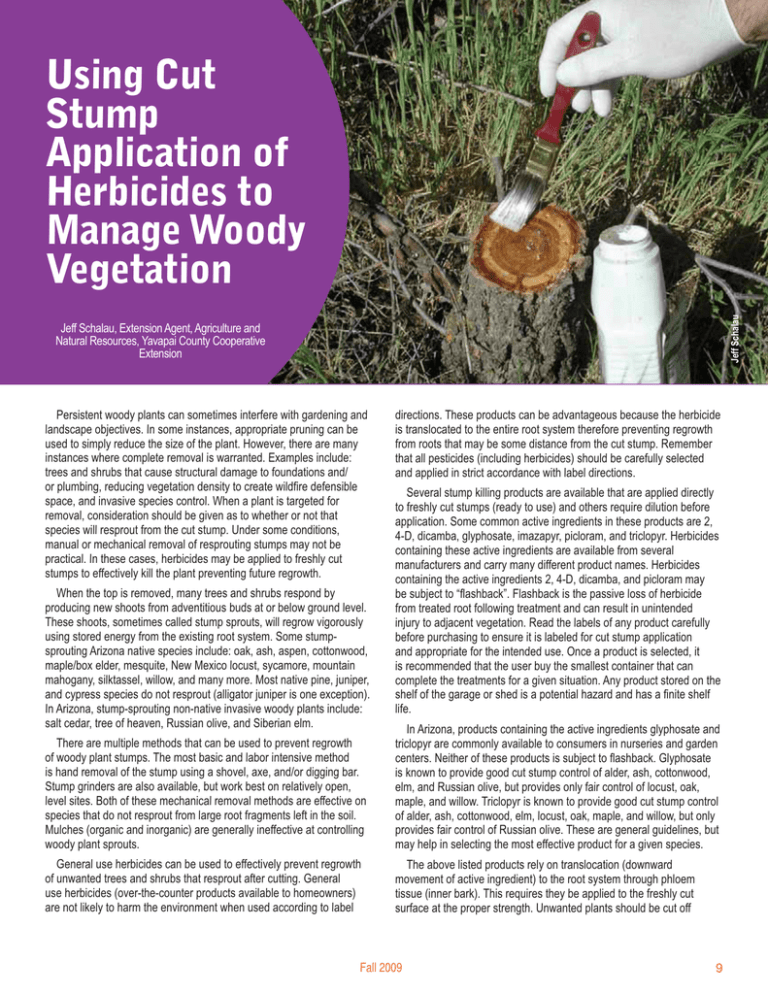
Jeff Schalau Using Cut Stump Application of Herbicides to Manage Woody Vegetation Jeff Schalau, Extension Agent, Agriculture and Natural Resources, Yavapai County Cooperative Extension Persistent woody plants can sometimes interfere with gardening and landscape objectives. In some instances, appropriate pruning can be used to simply reduce the size of the plant. However, there are many instances where complete removal is warranted. Examples include: trees and shrubs that cause structural damage to foundations and/ or plumbing, reducing vegetation density to create wildfire defensible space, and invasive species control. When a plant is targeted for removal, consideration should be given as to whether or not that species will resprout from the cut stump. Under some conditions, manual or mechanical removal of resprouting stumps may not be practical. In these cases, herbicides may be applied to freshly cut stumps to effectively kill the plant preventing future regrowth. When the top is removed, many trees and shrubs respond by producing new shoots from adventitious buds at or below ground level. These shoots, sometimes called stump sprouts, will regrow vigorously using stored energy from the existing root system. Some stumpsprouting Arizona native species include: oak, ash, aspen, cottonwood, maple/box elder, mesquite, New Mexico locust, sycamore, mountain mahogany, silktassel, willow, and many more. Most native pine, juniper, and cypress species do not resprout (alligator juniper is one exception). In Arizona, stump-sprouting non-native invasive woody plants include: salt cedar, tree of heaven, Russian olive, and Siberian elm. directions. These products can be advantageous because the herbicide is translocated to the entire root system therefore preventing regrowth from roots that may be some distance from the cut stump. Remember that all pesticides (including herbicides) should be carefully selected and applied in strict accordance with label directions. Several stump killing products are available that are applied directly to freshly cut stumps (ready to use) and others require dilution before application. Some common active ingredients in these products are 2, 4-D, dicamba, glyphosate, imazapyr, picloram, and triclopyr. Herbicides containing these active ingredients are available from several manufacturers and carry many different product names. Herbicides containing the active ingredients 2, 4-D, dicamba, and picloram may be subject to “flashback”. Flashback is the passive loss of herbicide from treated root following treatment and can result in unintended injury to adjacent vegetation. Read the labels of any product carefully before purchasing to ensure it is labeled for cut stump application and appropriate for the intended use. Once a product is selected, it is recommended that the user buy the smallest container that can complete the treatments for a given situation. Any product stored on the shelf of the garage or shed is a potential hazard and has a finite shelf life. There are multiple methods that can be used to prevent regrowth of woody plant stumps. The most basic and labor intensive method is hand removal of the stump using a shovel, axe, and/or digging bar. Stump grinders are also available, but work best on relatively open, level sites. Both of these mechanical removal methods are effective on species that do not resprout from large root fragments left in the soil. Mulches (organic and inorganic) are generally ineffective at controlling woody plant sprouts. In Arizona, products containing the active ingredients glyphosate and triclopyr are commonly available to consumers in nurseries and garden centers. Neither of these products is subject to flashback. Glyphosate is known to provide good cut stump control of alder, ash, cottonwood, elm, and Russian olive, but provides only fair control of locust, oak, maple, and willow. Triclopyr is known to provide good cut stump control of alder, ash, cottonwood, elm, locust, oak, maple, and willow, but only provides fair control of Russian olive. These are general guidelines, but may help in selecting the most effective product for a given species. General use herbicides can be used to effectively prevent regrowth of unwanted trees and shrubs that resprout after cutting. General use herbicides (over-the-counter products available to homeowners) are not likely to harm the environment when used according to label The above listed products rely on translocation (downward movement of active ingredient) to the root system through phloem tissue (inner bark). This requires they be applied to the freshly cut surface at the proper strength. Unwanted plants should be cut off Fall 2009 9 close to the ground just prior to treatment. The sooner the herbicide is applied, the more effective the treatment will be. On small stems or on plants that have been cut previously and subsequently resprouted, the bark may be frayed to expose more phloem and potentially increase herbicide uptake. The frayed area should be treated as well as the cut surfaces. Most labels recommend application of the herbicide within five minutes after cutting. When treating a small number of stumps, the herbicide can be applied with a small, inexpensive paint brush. Pour the necessary amount of herbicide into a disposable plastic cup to prevent sawdust and dirt from contaminating the herbicide in the original container. Triple rinse the paint brush and plastic cup and discard when finished. Applying the herbicide from a plastic spray bottle may be more suitable in situations where multiple treatments are necessary over an extended period. Set the spray bottle to deliver a stream rather than a mist and clearly label the bottle “Herbicide – Do Not Reuse”. Test-spray plain water from the bottle to ensure proper function and familiarize yourself with the spray pattern. Completely empty water from the spray bottle and add herbicide when you are ready to begin making applications. Pour the unused herbicide back into its original container when finished. Triple rinse the bottle, spray water to clean the pump then, render the spray bottle unusable (i.e. puncture bottle and cut the pump intake tube) and discard. When working with pesticides, always wear long-sleeve shirt, long pants, closed toe shoes, safety glasses, appropriate gloves, and other recommended personal protective equipment as per product label instructions. Plant susceptibility depends on a number of factors: time of year; stage of plant growth; type of application; soil moisture before, during, and after application; precipitation (rain or snow); and temperatures of soil and air before, at and immediately after the application. In general, fall applications are most effective because plants are translocating carbohydrates and proteins to their root systems. Herbicide active ingredients are more readily translocated at this time. Many woody plants are directly connected to neighboring plants of the same species and herbicide treatments can potentially be translocated to other individuals sharing that common root system. Suckers produced by roots of an adjacent tree are an example of a shared root system. Cutting and treating these sprouts with an herbicide can result in translocation of the active ingredient to the common root system and may ultimately kill non-target trees. In some cases, trees of the same species growing in a given area may have a common root system as a result of root grafting. Never use herbicides to treat sprouts coming off a root system of a tree that you want to keep or on plants that may be sharing a common root system. Sucker producing tree species include: tree of heaven, honey locust, black locust, hackberry, western soapberry, cottonwood, aspen, poplar, willow, box elder, and others. Always read and follow herbicide label directions carefully. This bulletin suggests ways to avoid problems, but does not supersede product label instructions or cover first aid, or storage and disposal requirements. The herbicide label lists hazards that may make it unsuitable for use in certain situations. Sustainability― Understanding and Putting It Into Practice ardly a week goes by without hearing the words sustainability, sustainable or sustainable development put into use somewhere or somehow. It’s no coincidence that the words are often used to describe our lifestyles, future and children’s future. This article describes the origins of “sustainability” and the areas of our lives where we can put the word into practice. Mark Apel H Mark Apel, Area Extension Agent, Community Resources Development University of Arizona Cooperative Extension, Southeastern Arizona 10 First, let’s take a look at a basic understanding of the word’s meaning and a little history into its emergence. The adjective “sustainable” means: “a: of, relating to, or being a method of harvesting or using a resource so that the resource is not depleted or permanently damaged, b: of or relating to a lifestyle involving the use of sustainable methods.” (Merriam-Webster’s On-line Dictionary) In 1987, the United Nations’ World Commission on Environment and Development issued a report titled Our Common Future also known as The Brundtland Report, named for the Commission’s chairwoman, Madame Gro Harlem Brundtland, who was the Prime Minister of Norway between the years 1981-1996. This report defined sustainable development as: & Backyards Beyond

